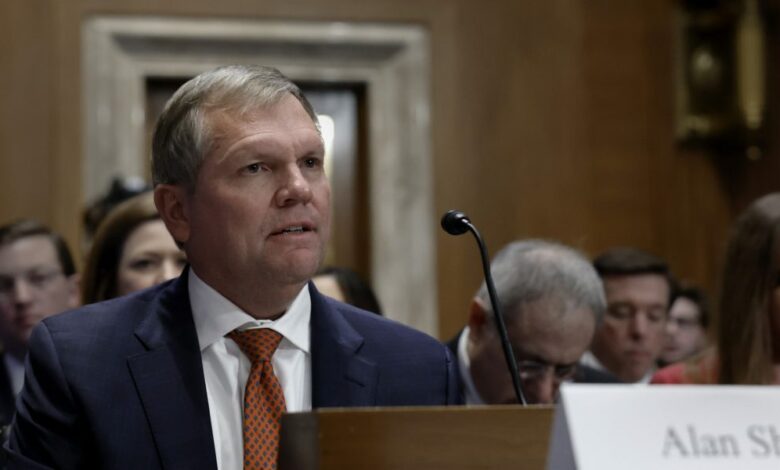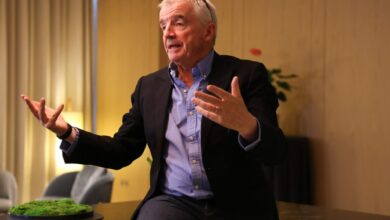Norfolk Southern is getting back on track–but activist investor Ancora is trying to derail it in a vicious proxy fight

The classic Edison Studios 1903 silent film “The Great Train Robbery”, one of the first commercial successes in movie history, staged a fictional heist on railroad tracks belonging to what is now Norfolk Southern. Over a century later, that same railroad, Norfolk Southern, risks being the scene of a genuine great train robbery.
This time, the assailants are being played by a struggling activist investor, Ancora, apparently looking to profiteer from a recent tragic accident clouding over the impressive crisis management of the railroad’s leadership and wildly flinging charges against Norfolk Southern to see what sticks. But in reality, Ancora is dramatically misconstruing Norfolk Southern’s trajectory of dramatic documented improvements over the last year, across safety, efficiency, and profitability–and the choice between Norfolk Southern’s proven strategy and Ancora’s activist challenge could not be more stark, as we show in our comprehensive original analysis found here.
Norfolk Southern’s safety improvements
Ancora initially launched its activist campaign against Norfolk by excoriating Norfolk Southern’s response to the East Palestine tragedy, which has loomed large over Norfolk Southern over the last year and almost needs no amplification at this point. On Feb. 3, 2023, merely months after he started as CEO, Norfolk Southern’s Alan Shaw was confronted with one of the worst railroad disasters in recent history: a 151-car freight train derailed in the village of East Palestine, Ohio, leading to the release of hazardous chemicals and a temporary evacuation of the entire area. Mercifully, there were no deaths or injuries but a national outcry over rail safety ensued.
However, Ancora’s attacks over how Shaw handled East Palestine landed with a thud, since it was hardly supported by any factual evidence nor the lived experience of those involved in the East Palestine tragedy, making it look like a rather naked attempt to profiteer by exploiting the community’s suffering.
Top East Palestine community leaders have expressed their appreciation that Shaw and his team followed the model of successful corporate crisis management responses. Rather than dispatching PR firms or midlevel deputies, or hiding behind smokescreen statements of corporate legalese, Shaw and his top deputies decamped to East Palestine themselves, and forged genuine personal relationships with local leaders and residents. Aided by hundreds of their own employees on the ground, they established clean-up partnerships with municipal, state, and federal officials focusing on environmental rehabilitation, economic development projects, remuneration to homeowners and businesses, and personal counseling. Over the last year, Norfolk Southern has invested well over $700 million dollars into the local community, showing good-faith execution of company promises.
Ancora’s attacks on overall rail safety similarly missed their mark. There is no doubt that Norfolk Southern has had historical challenges with safety, but Shaw has led the company in completely transforming its internal safety processes and practices, not only by increasing staffing on railcars and fostering a stronger safety culture within the workforce but also through next-generation safety innovations such as integrating AI and automation into train inspections and piloting new hot bearing detectors.
The data clearly shows that Shaw’s safety improvements are working. As we show here in our comprehensive original analysis, according to datasets from the Federal Railroad Administration, in 2023, compared to U.S. Class I railroad peers, Norfolk Southern was the single safest railroad in the nation with the lowest total number of mainline accidents, and the greatest percentage drop in accidents from the year before. So far in 2024, Norfolk Southern has sustained that progress as the single safest railroad.
No wonder that Ancora’s unwarranted mudslinging over safety catalyzed an unprecedented array of regulators, labor leaders, local officials, and NS employees to rush to Shaw’s defense. The mayor of East Palestine, Trent Conaway, argued, “Norfolk Southern has taken responsibility…and helped the village. They are contributing to the village. They’ve been good partners.”
Amit Bose, the administrator of the Federal Railroad Administration, declared that “any backsliding as a result of a change in leadership…on the safety-oriented path Norfolk Southern has laid out and communicated with us will…attract renewed oversight attention from my office as we pursue our safety mission.”
Bose was joined by his counterpart, the powerful chairman of the Surface Transportation Board, Marty Oberman, who was unambiguous about whose side he stood on: “For Ancora to condemn the management of Norfolk Southern, it shows a lack of understanding about moving freight around the country.” An influential union leader, Scott Bunten, was even more pithy: “Ancora’s plan will decimate the railroad all over again.”
Efficiency and productivity turnarounds under Alan Shaw
After running up against such a strong show of support for Norfolk Southern’s improved safety track record, the activist then latched onto productivity and efficiency as key areas for improvement, disingenuously promising that if the activist slate won, they would bring Norfolk Southern’s operating ratio (OR) down well below 60% within 13-14 months–a wildly unrealistic proposition. The reality is that as Chairman of the Surface Transportation Board Marty Oberman pointed out, “the rapid reduction in OR championed by Ancora can only be accomplished by major new reductions in the workforce.”
Firings of that magnitude are not likely to pass muster with Biden Administration regulators, so perhaps it is no wonder Ancora has refused to meet with Oberman despite his direct regulatory/supervisory role over the nation’s rail systems. It is hard to imagine how Ancora can build a productive relationship with regulators whom they have alienated so dramatically through their disingenuous false promises.
But even setting aside Ancora’s wildly unrealistic targets, there is no question that investors are seeking improved efficiency and productivity at Norfolk Southern, and management is now freshly focused on delivering with aplomb. Over the past year, Norfolk Southern’s average train velocity has increased by 25%, and continued acceleration will produce $550 million in total velocity-related savings over the next three years. Increased velocity not only amounts to a less expensive, more reliable railroad but also higher quality service with more volume and pricing power as goods get picked up and delivered on time.
Norfolk Southern has also reduced average dwell time by 33% over the last year, reducing needless waits and costly overtime. It speaks to Norfolk Southern’s underappreciated operational prowess that the company had the fewest number of embargoes of any North American Class I railroad in Alan Shaw’s first year as CEO–but management is continuing to drive further efficiency and productivity improvements and is en route to bringing OR down below 60% by 2026, a far more realistic target than the activist’s. All this is a testament to Norfolk Southern’s focus on improving efficiency but not running afoul of regulators in doing so, unlike Ancora’s slash-and-burn approach.
A golden age for railroad growth
Some financial analysts and commentators are inclined to view Ancora’s activist challenge to Norfolk Southern as another railroad basket case where activists can and should shake things up, even beyond any specific concerns over safety, efficiency, or productivity. After all, to some investors, the entire railroad industry is renowned for bloat, with its duopoly structure and impenetrable moat entrenching complacency.
As activist investor and CNBC commentator Kenneth Squire quipped, “Inside the activist world, [going after a railroad] is as sure of an activist strategy as there is,” pointing out there have been no less than four prominent cases over the last decade where activists successfully replaced a rail CEO. And in all four cases, activist involvement significantly improved the subsequent financial and operational performance of those railroads. Further helping Ancora is the ostensible stature of several of their board candidates, including the well-regarded former UPS COO Jim Barber as well as the virtuous former Ohio Governor John Kasich, with Ancora boosters even suggesting that their activist slate could emerge as the next Hunter Harrison.
But what these boosters miss is that times have changed in the railroad industry, and there will never be another Hunter Harrison. Harrison, a legend in the rail industry, was renowned for inventing precision scheduled railroading ( PSR), which improved efficiency at the cost of slashing workforces, reducing maintenance budgets, and taking shortcuts, often to the frustration of customers and regulators. Harrison, and his vision of PSR, was a product of a specific time and place. Today, a stricter regulatory climate and changing political winds make that approach increasingly unfeasible, as even Harrison himself began to acknowledge towards the end of his life.
Alan Shaw is not and will never be Hunter Harrison, but what Alan Shaw is doing now makes him the right leader at the right time. Shaw is pioneering a radically different approach. He and his new COO John Orr call it “PSR 2.0”. It builds on the best of PSR 1.0 in driving efficiency and productivity while making up for what PSR 1.0 sacrificed: quality of service and customer satisfaction. As Orr puts it, “It means taking a broader view on what you’re trying to achieve. It’s not just a myopic slash-and-burn perspective on reducing costs and expenses. It’s having a responsibly managed operating plan that’s reliable and repeatable and underpinned by the value of safety. That creates growth opportunities because you’re able to then respond to emerging growth opportunities in the marketplace.”
And there is certainly no shortage of emerging growth opportunities for the railroads to capture. Some rail experts, such as Eric Mandelblatt of Soroban Capital, are calling this the “golden age for railroading growth,” the result of a unique, once-in-generation confluence of secular tailwinds, as we examine more in-depth in our comprehensive slide deck here.
Most important and transformative of all, North American railroads have a once-in-a-generation opportunity to benefit from reshoring, friend-shoring, and the resurgence in North American manufacturing. Thanks in part to large-scale fiscal stimulus such as the $1.2 trillion Infrastructure and Jobs Act, the $738 billion Inflation Reduction Act, and the $280 billion CHIPS Act, domestic industrial manufacturing will continue to surge for years to come, with the U.S. Census Bureau already reporting a near-tripling in monthly U.S. construction spending on manufacturing over the last three years. Railroads are prime beneficiaries of higher spending on industrial manufacturing, due to the large scale and heavy nature of difficult-to-transport materials.
Furthermore, manufacturers will continue to re-shore supply chains to North America from Asia amidst rising geopolitical tensions, and the magnitude of this re-shoring is already captured in trade data: Whereas China was America’s largest trade partner by far merely five years ago, doing 30% more trade than the U.S. did with either Mexico or Canada, China has now fallen to third place with both of Mexico and Canada each doing nearly 30% more trade than the U.S. does with China.
Another secular tailwind is the growth in U.S. commodity production volumes. The U.S. has become the world’s energy superpower as the leading producer of oil, producing more oil than any country in history and nearly 50% more than each of the runner-ups, Saudi Arabia and Russia. The U.S. has also become a leading producer of natural gas, copper, lithium, and other commodities, including several which are vital to the EV and electric battery supply chain.
The bulk commodities and the heavy materials required to produce commodities require rail transportation, so rising commodities production domestically is directly levered to rising rail volumes. Furthermore, though some fear the declining use of coal in North America will hurt rail revenues, global demand for coal continues to surge year after year, especially for metallurgical coal, which is vital and irreplaceable in the steelmaking process. Even North American thermal coal producers are finding healthy global demand for their product on the global export market, so coal will likely remain a significant driver of rail revenues for decades to come.
As these tailwinds, as well as the rise of e-commerce, drive increased freight and transport needs across the supply chain, railroads have a unique opportunity to recapture lost market share from their primary competitors, trucks. As Alan Shaw recently pointed out, “Over the last 20 years, rail has ceded share to truck. Truck volumes are up about 30%, while rail volumes are down about 30%. There’s only one reason, and that’s because rail has not been able to compete based on service. The rail industry goes through a service meltdown, and that causes customers over time to ship business that should be on rail over to truck.”
At least on paper, rail should have every advantage over trucks amidst increased freight demands. Shipping by truck is not only three to four times more expensive than by rail–but truckers are also far more vulnerable than railroads to rising labor and fuel cost inflation since trucks require far more workers than rail to carry smaller amounts of freight per trip. Railroads are also key in the fight against climate change, since shipping by truck releases four times more carbon emissions into the environment than by rail.
The opportunity for railroads to recapture market share from trucks through higher-quality service is massive. Amazingly, over the last decade, rail revenue growth trailed US GDP growth by nearly 50%, with rail revenues stagnant or even declining while U.S. GDP growth surged.
But Ancora’s plans, which essentially amount to doubling down on a wildly unrealistic, exaggerated rip-off of PSR 1.0, threaten to derail all the progress Alan Shaw has made towards recapturing revenue growth. As Surface Transportation Board Chairman Marty Oberman said in no uncertain terms, “Clearly, Ancora’s plan is to install a CEO ordered to reverse Norfolk Southern’s recently instituted corporate strategy to maintain a resilient workforce and to invest more in infrastructure to grow the railroad’s capacity long term…Norfolk Southern has been one of the leaders in shifting gears and building workforce and capital investment for the future. Now it threatens to be punished for that activity by an activist investor.”
There is every reason to think that Alan Shaw has the right plan to capture the benefits arising from the unique secular tailwinds underlying the rail industry right now. If railroads can improve their quality of service under PSR 2.0, with genuine investments into their operations, as opposed to the myopic slash-and-burn of PSR 1.0, railroads can drive revenue growth as a complement to, and not at the cost of, increased efficiency, productivity, and safety. This is an unmitigated win for all stakeholders, from shareholders to customers to the general public.
A genuine track record vs. failing investors
Despite the underperformance of most activist funds, Ancora’s failures still stand out, with the magnitude of their underperformance striking even when compared to other underperforming activist track records.
Not only has Ancora lost many of its proxy fights, but even more importantly, Ancora’s investment returns in its Ancora Catalyst Master Fund have dramatically underperformed all major indices (S&P 500, Dow Jones, and Nasdaq 100) and even Norfolk Southern stock itself across virtually every time span we measured, as we detail in our more comprehensive slide deck here. In fact, an investor could have generated stronger investment performance from low-yielding government bonds than Ancora’s returns.
Despite Ancora’s dramatic underperformance, and despite holding a puny 0.15% ownership stake in Norfolk Southern as of the end of 2023, Ancora had the audacity to nominate eight board members to the 13-seat board of Norfolk Southern. In short, Ancora has made clear that they are after nothing short of engineering full control, having repeatedly rejected settlements proposed by Norfolk Southern’s board which would give Ancora multiple board seats but not a majority. To have an undistinguished minority investor with a 0.15% ownership stake, a track record of underperformance, and no industry experience, demand complete control and refuse reasonable settlements is a nearly unprecedented situation for any company, and makes this proxy fight substantively different than every railroad proxy fight before.
Unfortunately, rather than making their argument factually, Ancora has resorted increasingly to shrill ad hominem personal attacks. In a recent CNBC interview, Ancora Alternatives President Jim Chadwick said in no uncertain terms, “The problem is Alan Shaw,” attacking the CEO in deeply personal terms and making it clear that Ancora will settle for nothing short of his immediate ouster.
But evidently, to many Norfolk Southern stakeholders, the problem is actually Ancora’s own activism leader, Jim Chadwick. In a recent Stephens customer survey of dozens of rail customers representing over $25 billion in annual transportation spending, when asked “Whose strategic plan do you prefer”, an overwhelming 86% of respondents selected Alan Shaw’s, 14% were indifferent, and 0% preferred the activist’s. Some 91% of respondents believed that Ancora’s strategic plan would make Norfolk Southern’s rail service worse in the next year, while 0% believed it would get any better. Not exactly an inspiring show of support for Ancora from Norfolk Southern’s key customers, who know you can’t “train on the job.”
Given the escalating unreasonableness of Ancora’s demands, perhaps it is not coincidental that even one of Ancora’s own director nominees has wisely withdrawn her name from consideration, with perhaps more to follow. After all, few business executives relish the prospect of draining ad hominem warfare. Perhaps it is not coincidental that Ancora has lost support even within fellow activists: Although Ancora had originally trumpeted that it was cooperating with, and had the support of EdgePoint Investment Group, a Toronto-based investor holding a 2% ownership stake in Norfolk Southern, Ancora quietly informed the SEC that EdgePoint had terminated all cooperation with Ancora a few weeks back.
We sent our findings on Ancora’s underwhelming returns to Jim Chadwick and his Ancora colleagues by email, but despite acknowledging receipt, they never responded or engaged further.
Some may think of railroads as an industry of the past and the concept of railroad backroom battles may seem so quaintly 19th century, but in reality, the centrality of railroads to the 21st-century economy is underappreciated–and brings massive potential for significant revenue growth.
It seems Norfolk Southern CEO Alan Shaw can proudly sing the old folk song, ‘I’ve been working on the railroad all the live long day,” with strong demonstrated results, despite the noise from activist Ancora’s efforts to derail his success. Norfolk Southern shareholders should cheer as this company pulls into the station, guided by Alan Shaw’s steady hand, despite Ancora’s attempts to derail Norfolk Southern through unrealistic promises.
Jeffrey Sonnenfeld is the Lester Crown Professor in Management Practice and Founder and President of the Yale Chief Executive Leadership Institute. In 2023, he was named “Management Professor of the Year” by Poets & Quants magazine.
Steven Tian is the director of research at the Yale Chief Executive Leadership Institute and a former quantitative investment analyst with the Rockefeller Family Office.
More must-read commentary published by Fortune:
- Union leaders: Larry Fink is right about the retirement crisis Americans are facing–but he can’t tell the truth about the failure of the ‘401(k) revolution’
- We analyzed 46 years of consumer sentiment data–and found that today’s ‘vibecession’ is just men starting to feel as bad about the economy as women historically have
- 90% of homebuyers have historically opted to work with a real estate agent or broker. Here’s why that’s unlikely to change, according to the National Association of Realtors
- Intel CEO: ‘Our goal is to have at least 50% of the world’s advanced semiconductors produced in the U.S. and Europe by the end of the decade’
The opinions expressed in Fortune.com commentary pieces are solely the views of their authors and do not necessarily reflect the opinions and beliefs of Fortune.
Source link




